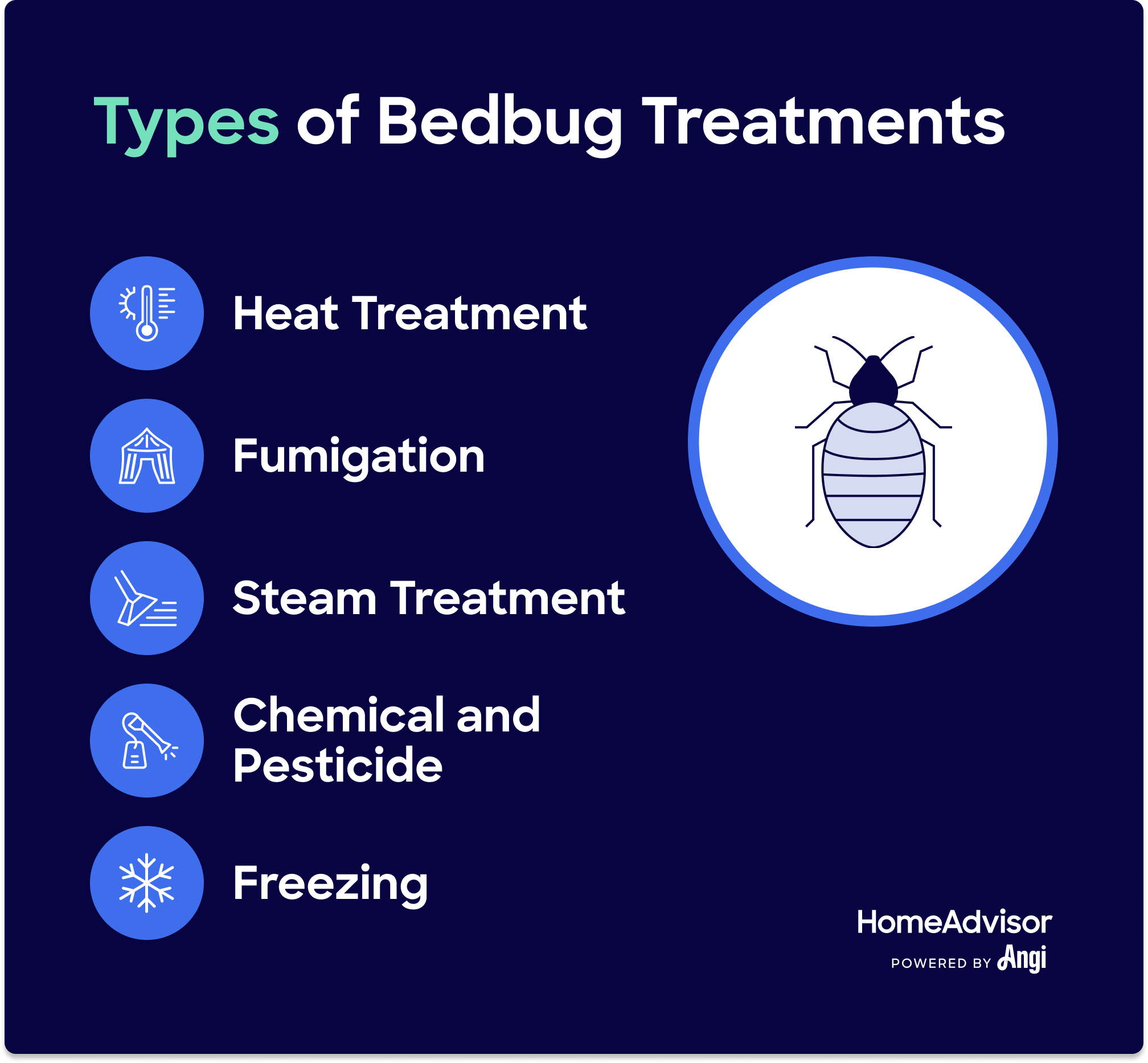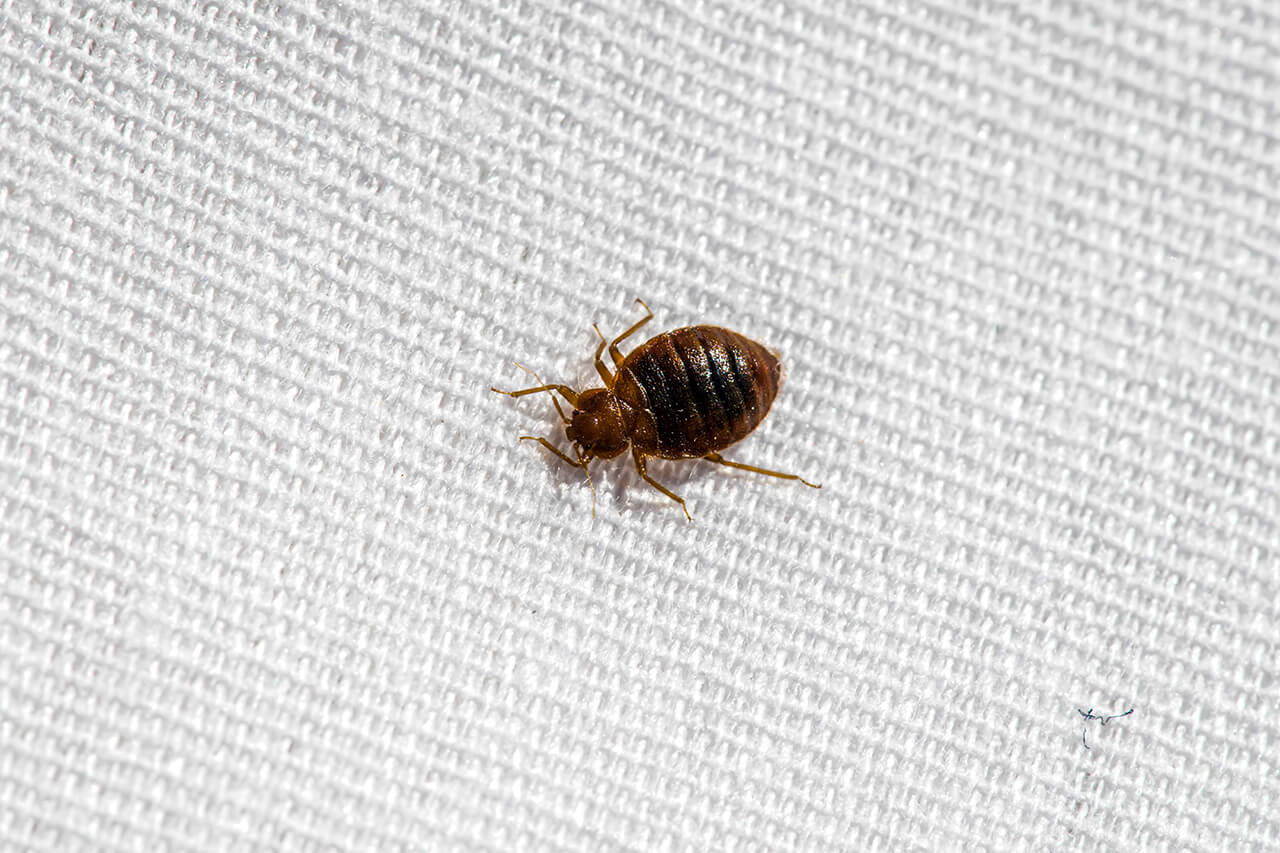How Much Do Bedbug Exterminators Cost in 2022?
Typical Range:
$300 - $5,000
Typical Range:
$300 - $5,000
Cost data is based on research by HomeAdvisor.
Updated January 23, 2023
Written by HomeAdvisor.Bedbug treatment costs $1,750 on average. The level of infestation, the size of the space, and the type of treatment will all affect the price. You could pay as low as $300 for a small problem and as much as $5,000 to clear a large house of a serious infestation.
Bedbugs are a problem that you can't ignore. They spread rapidly, can be tough to get rid of once the infestation takes hold, and can cause health problems. It's crucial to take action as soon as you notice a problem to stop the bugs from spreading and to keep your home healthy and free of pests.
| Average Cost | High Cost | Low Cost |
|---|---|---|
| $1,750 | $5,000 | $300 |
The type of bedbug treatment has a major impact on prices. Chemical and pesticide treatments are some of the most affordable and effective options, but they’re also the harshest. Heat treatment is chemical-free, but it may leave behind surviving eggs and insects, resulting in the need for additional treatments.
Steam and freezing methods are the most effective chemical-free options, but these come at a premium cost. However, both methods are often a good investment due to their high success rate from a single treatment.
| Bedbug Treatment Type | Average Cost Range per Sq. Ft. |
|---|---|
| Bedbug heat treatment | $1 – $3 |
| Bedbug fumigation | $4 – $7.50 |
| Steam treatment | $2 – $7.50 |
| Chemicals and pesticides | $2.50 – $4.50 |
| Freezing | $3 – $6 |
Heat treatment is a low-cost, reasonably effective method of eliminating bedbugs at around $1 to $3 per square foot or $100 to $500 per room. The spaces in your home with bedbugs are heated to up to 145 degrees Fahrenheit with hot air, which kill bedbugs and their eggs. The hot air circulates with powerful fans for around an hour when you’re not home.
This treatment option is effective and doesn't use chemicals, but it can damage items sensitive to high temperatures, so you need to move anything susceptible to damage. Additionally, while heat treatment kills the bedbugs and already present eggs, it doesn't prevent reinfestation.
Fumigation costs between $4 and $7.50 per square foot or roughly $500 to $1,000 per room. Fumigation involves the application of pesticides, so you have to stay out of your home during treatment until the chemical residue reaches a safe level. This can vary from a few days to a week, depending on the severity of the infestation and the chemicals used to fight it.
With fumigation, your whole home is tented or sealed off and chemicals are pumped inside. This is a very effective treatment as the gas can reach into tiny cracks and areas you may otherwise miss. However, it doesn't prevent reinfestation, and the chemicals used are potent and dangerous, known for giving off volatile organic compounds (VOCs) that can cause long-term health problems.
At a cost of approximately $2 to $7.50 per square foot, steam treatment costs between $250 and $1,000 per room. Steam treatment kills bedbugs faster than heat treatment and uses no chemicals, just super-heated water vapor. The steam reaches 200 degrees Fahrenheit or higher and rapidly kills pests. However, it usually takes several passes to let the steam fully penetrate soft surfaces and kill every bug and egg in its path. Note that the temperature and moisture can damage heat- and water-sensitive items like electronics and wood.
A steam treatment is only suitable for small areas, but it effectively penetrates soft things like mattresses and eradicates bedbugs and their eggs, so it's a great choice for the early stages of an infestation.
Treating bedbugs with chemicals costs between $2.50 and $4.50 per square foot or between $200 and $600 per room.
You can choose from natural pesticides and chemical ones. Pyrethrins are six naturally occurring substances from chrysanthemums that are poisonous to insects, including bedbugs. Diatomaceous earth is fine fossilized diatoms and is an example of a desiccant that attaches to the exoskeleton of the bugs and the outer layer of their eggs, drying them out.
Synthetic options include pyrethroids, pyrroles, neonicotinoids, and insect growth regulators. Each chemical acts in a different way. Desiccants dry out the bugs, killing them from the outside in. Some prevent reproduction and egg growth. Others act as contact poisons, while others perform at a cellular level.
Freezing bedbugs costs between $3 and $6 per square foot or $400 to $800 per room. Bedbugs are temperature-sensitive and can't tolerate high or low extremes. So, pest control pros near you pump in dry ice "snow" that's extremely cold and kills the bedbugs and their eggs on contact. However, the bedbugs sometimes get blown away by the force of the snow's entry. Plus, the dry ice doesn't penetrate dense, soft surfaces like mattresses very effectively, so it takes an experienced pro to make this method work well.
However, it's a great chemical-free choice for homes with many immovable objects sensitive to heat.
Several elements play into your bedbug extermination bill. These include home size, location, treatment method, and more. Here are the main factors that can affect your final cost.
Professional bedbug exterminators near you charge by the room, square footage, or a flat fee. Home size can significantly impact the price, particularly for bedbug heat treatment costs and other methods that require filling an entire space.
| House or Apartment Size | Average Cost Range per Visit |
|---|---|
| Studio or 1 bedroom | $300 – $900 |
| 2 – 3 bedrooms | $400 – $1,200 |
| 3 – 4+ bedrooms | $800 – $2,500 |
People living in cities with more rampant infestations could pay up to three times more than those in less-prone areas. In areas with higher demand, local pest control companies will charge more for their services. The cost of living can also impact what companies in your area charge.
Some U.S. cities with higher extermination rates include the following:
Baltimore
Chicago
Cincinnati
Detroit
District of Columbia
Houston
Indianapolis
Los Angeles
New York City
Philadelphia
Raleigh, North Carolina
San Diego
San Francisco
Some exterminators offer free inspections, especially for new customers. Others may charge around $65 to $200 for a visual inspection. If you hire that company for extermination services, they may remove the inspection fee from your treatment bill.
Aside from visual inspections, some exterminators also employ trained dogs to sniff out the rotten berry-like odor of bedbugs. This service ranges from $300 to $600 for an average-size home. Hotels and other large buildings will run closer to $900 to $1,200. These expert-trained dogs detect infestations and often have higher accuracy than humans.
A moderate infestation size will cost around $200 to $300 per room to treat, while a severe infestation will cost $300 to $400 per room or between $4,000 and $6,000 for a whole-home treatment. The denser the infestation, the more labor and product you’ll need to wipe out the bedbugs.
If an infestation requires multiple visits to eradicate, pros may charge a flat rate for monthly, semi-monthly, or quarterly treatments. Frequent treatments cost more per year, but they usually have a price break per visit.
| Frequency of Visits | Average Cost Range per Year |
|---|---|
| Monthly | $5,000 – $7,500 |
| Semi-monthly | $5,500 – $8,500 |
| Quarterly | $1,800 – $2,500 |
Most exterminators offer competitive pricing. However, getting multiple quotes and comparing costs is helpful before hiring.
| Exterminator Brand | Average Cost Range for Services | Service Guarantee |
|---|---|---|
| Arrow Exterminators | $500 – $2,800 | 30 days |
| Ehrlich Pest Control | $650 – $3,000 | 30 days |
| Orkin | $400 – $3,000 | 30 days |
| Terminix | $500 – $2,000 | 30 – 90 days |
| ThermaPure | $2,000 – $4,000 | 100% effectiveness |
DIY methods for bedbug extermination typically cost less than professional treatment, but these options are risky. There's a lot of planning, research, and evaluation necessary to determine the best approach, all of which take a lot of work to pull off with an untrained eye. If unsuccessful, you could end up with a worse infestation than before.
DIY bedbug extermination kits are available for between $50 and $200. You can also buy a steamer to steam-treat for about $30 to $400. The lower price point buys a handheld unit, while a more efficient heavy-duty steamer will cost approximately $150 to $400. You can also use diatomaceous earth, a nontoxic dust that typically costs around $10 for 2 pounds and $25 for 10 pounds.
There are several ways to self-diagnose a bedbug infestation in your home. The bugs are oval-shaped and around a quarter-inch long, with brown or reddish-brown bodies. However, they typically hide and are difficult to spot, so look for these signs:
Clusters of small red bites that give a burning, itching sensation
Rust-colored spots on the mattress
Blood stains on the bedsheets
Musty, berry-like odor
You can take many precautions to keep bedbugs from invading your bed and your home. Here’s what you can do:
Wash your clothes in hot water after traveling.
Keep your luggage away from hotel mattresses and floors when traveling.
Wash secondhand clothing immediately.
Inspect and disinfect used items before you bring them inside, especially furniture.
Seal up any possible thruways, such as cracks in the walls and gaps under doors.
Vacuum often.
Protect your mattress with a special mattress cover.
Keep an eye out for rust-colored spots.
Reduce clutter around your home.
Check pets and pet accessories for warning signs of bedbugs.
Fogger bombs are mostly ineffective at handling a bedbug infestation because they can only reach exposed bugs. Bedbugs tend to hide within the mattress or in crevices around the room and will likely survive a fogger. Instead, steam and freezing methods are the most effective chemical-free options and have a high success rate from a single treatment. There are also chemical treatments that are affordable and effective.
Bedbugs can spread quickly since they can travel at a rate of 3 to 4 feet per minute on nearly any surface. It’s important to call a professional exterminator as soon as you find a bedbug infestation before a minor nuisance becomes a severe infestation.
The most common professional treatments are pyrethrins and pyrethroids. Pyrethrins are plant-based insecticides derived from chrysanthemum flowers. Pyrethroids are synthetic and made to act in the same way as pyrethrins to eliminate bedbugs.
According to the U.S. Environmental Protection Agency (EPA), bedbugs haven’t shown signs of transmitting disease. However, they’re still a public health pest with a variety of physical effects, including the following:
Allergic reactions, including anaphylaxis in rare cases
Secondary infections on the skin from bite wounds
Mental health impacts such as anxiety and insomnia

